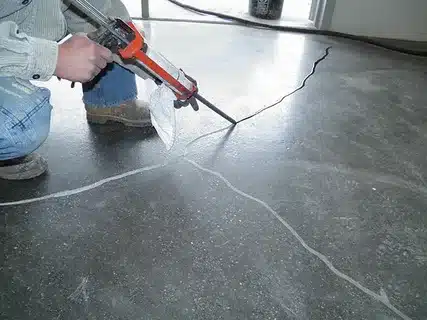Concrete is one of the most durable and long-lasting building materials used in driveways, sidewalks, patios, and foundations. However, even concrete surfaces can develop cracks over time due to factors like weather, settling, or general wear and tear. Repairing these cracks is essential not only for the aesthetic appeal of your surfaces but also for maintaining their structural integrity. In this article, we will explore easy and effective methods for repairing cracks in concrete, ensuring a smooth and durable finish.
Why Concrete Cracks?
Before diving into the repair process, it’s important to understand why concrete cracks in the first place. Several factors can contribute to the development of cracks in concrete:
- Settling: As the soil underneath the concrete settles, it can cause the surface to crack.
- Moisture: Water can seep into the concrete, causing it to expand and contract, leading to cracks.
- Temperature Fluctuations: Changes in temperature can cause concrete to expand in the heat and contract in the cold, which may cause cracking.
- Heavy Loads: Vehicles or other heavy loads can put stress on concrete surfaces, causing cracks over time.
- Poor Installation: Improper mixing or insufficient curing can also result in weak concrete prone to cracking.
Steps for Repairing Small Cracks in Concrete
For minor cracks in concrete, you can follow a relatively simple process. Here’s a step-by-step guide to repair small cracks yourself.
Clean the Crack
Before you can repair the crack, you need to clean it thoroughly. This ensures that no dirt, debris, or loose concrete will interfere with the repair material.
- Tools Needed: Wire brush, broom, vacuum, or a pressure washer.
- Process: Use a wire brush to scrub out any dirt or debris inside the crack. Sweep away any loose particles and vacuum the area to remove all remaining dust. If the crack is large, consider using a pressure washer to ensure a clean surface.
Prepare the Crack for Filling
For a strong bond between the crack and the repair material, you may need to widen the crack slightly. This is especially important if the crack is narrow and has sharp edges.
- Tools Needed: Hammer and chisel or a concrete grinder.
- Process: Use the hammer and chisel to widen the crack by about 1/4 inch. This will help the filler material to bond better with the concrete. Ensure that the edges of the crack are smooth.
Choose the Right Filler
There are several types of fillers available for concrete crack repair. The type you choose will depend on the size and location of the crack.
- Concrete Patch: For larger cracks, a concrete patching compound is a good choice. It can fill deeper cracks and can be applied in layers.
- Caulk or Sealant: For smaller cracks, a concrete caulk or sealant will suffice. It is easy to apply and works well for cracks up to 1/2 inch wide.
- Epoxy: For structural cracks or cracks in foundations, epoxy resin offers the best solution. It provides a strong bond and can withstand significant stress.
Apply the Filler
Once you’ve chosen the right filler, it’s time to apply it. Follow the instructions provided by the manufacturer for the best results.
- For Concrete Patch: Use a putty knife or trowel to apply the patching compound into the crack. Press it in firmly to ensure it fills the crack completely. Smooth the surface with the putty knife.
- For Caulk or Sealant: Cut the tip of the caulk tube and apply a thin bead of sealant directly into the crack. Use a putty knife to smooth it over the surface.
Smooth the Surface
After the filler is applied, smooth the surface to ensure that it is level with the surrounding concrete. Use a wet sponge or a trowel to smooth the filler and remove any excess material.
Allow the Repair to Dry
Let the filler cure as per the manufacturer’s instructions. Curing times can vary depending on the type of filler used. It’s crucial to let the repair dry completely before using the surface.
- Time: Most concrete fillers will take 1-2 hours to dry to the touch, but it’s best to wait 24-48 hours for full curing.
Repairing Larger Cracks
Larger cracks in concrete require a more extensive repair approach. For these cracks, you may need to use a concrete bonding agent or even resurface the entire area if the damage is significant.
Clean the Crack and Surrounding Area
Follow the same cleaning steps as outlined for smaller cracks. Make sure to remove all dirt and debris.
Apply Bonding Adhesive
For larger cracks, applying a bonding adhesive can help ensure a solid bond between the old concrete and the new filler.
- Tools Needed: Concrete bonding adhesive.
- Process: Apply the bonding adhesive along the crack and allow it to set as per the manufacturer’s instructions.
Apply Concrete Patch or Epoxy
Once the bonding adhesive is dry, fill the crack with a concrete patch or epoxy resin, depending on the severity of the crack.
- Process: Press the patch or epoxy into the crack, smoothing it over to ensure it is level with the rest of the surface.
Resurface (If Needed)
If the crack is too large or if the concrete surface is severely damaged, resurfacing the entire area might be necessary. This involves applying a thin layer of fresh concrete over the existing surface.
- Tools Needed: Concrete resurfacer.
- Process: Mix the resurfacer and apply it to the surface, covering the entire area. Use a trowel to smooth the new layer.
When to Call a Professional
While many concrete crack repairs are DIY-friendly, some situations call for professional help. If you are dealing with extensive damage, such as deep cracks in a foundation or structural issues, it’s best to call a professional contractor who specializes in concrete repair. They have the expertise and tools to handle complex issues safely and effectively.
Conclusion
Repairing cracks in concrete is an important task to maintain the structural integrity and appearance of your surfaces. Whether you’re fixing small cracks yourself or dealing with larger issues, the right tools and techniques can make all the difference. By following these easy and effective methods, you can restore your concrete surfaces to their original condition and extend their lifespan. Always choose the appropriate filler for your crack size, and if necessary, seek professional assistance for more complex issues. With the right care, your concrete surfaces can stay strong, smooth, and durable for years to come.
FAQs
How long will my concrete crack repair last?
If done properly, concrete crack repairs can last for many years. The lifespan of the repair depends on the severity of the crack, the materials used, and the type of concrete.
Can I repair cracks in concrete during winter?
It’s best to repair cracks in concrete during mild weather. Cold temperatures can slow down the curing process of certain repair materials. If you must repair in winter, ensure that the repair material is suitable for low temperatures.
Will the crack reappear after I repair it?
A3: If the cause of the crack (such as soil shifting or water infiltration) is not addressed, the crack may reappear. Ensure that the underlying cause of the damage is fixed for a more permanent repair.
Can I use regular cement to repair cracks?
A4: Regular cement may not be suitable for repairing cracks, especially if they are large. It’s better to use a concrete patching compound or specialized filler for better adhesion and flexibility.
How do I prevent cracks in concrete from happening again?
To prevent future cracks, ensure proper drainage around the concrete, avoid heavy loads on the surface, and maintain the concrete by sealing it regularly. Proper installation and curing are also key to reducing the chances of cracking.

